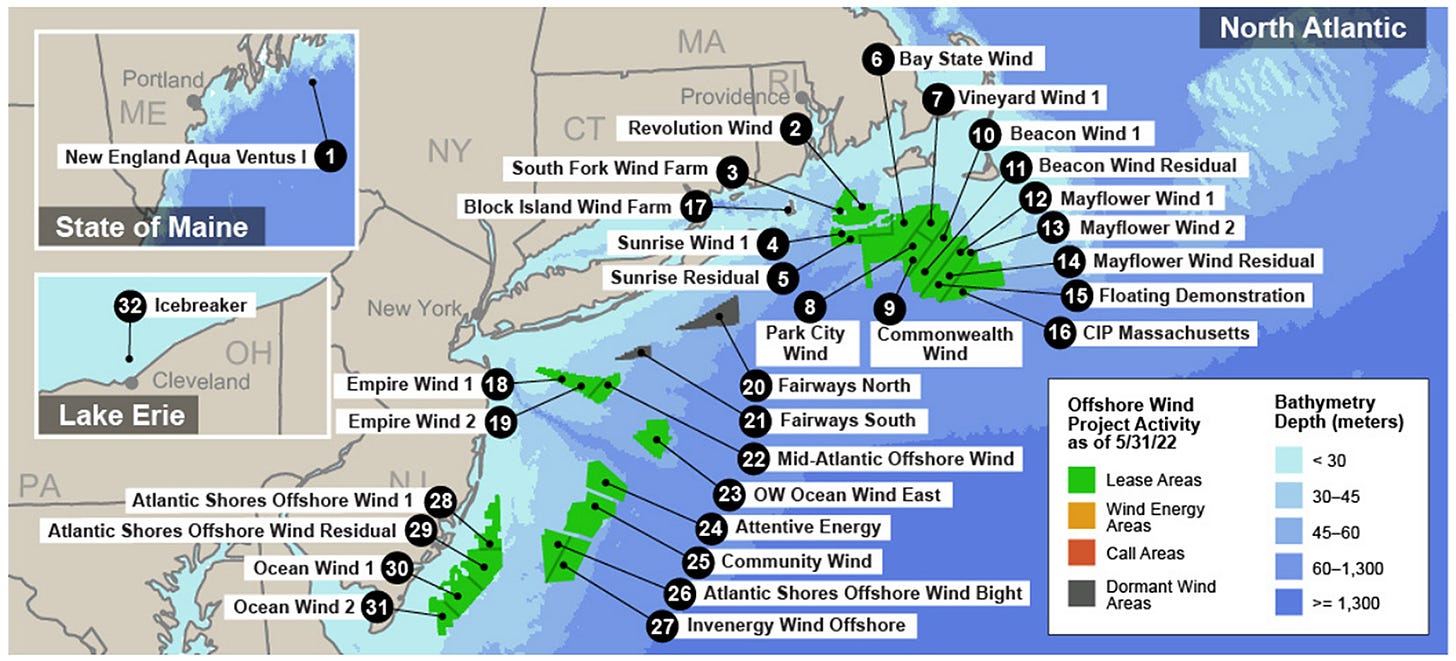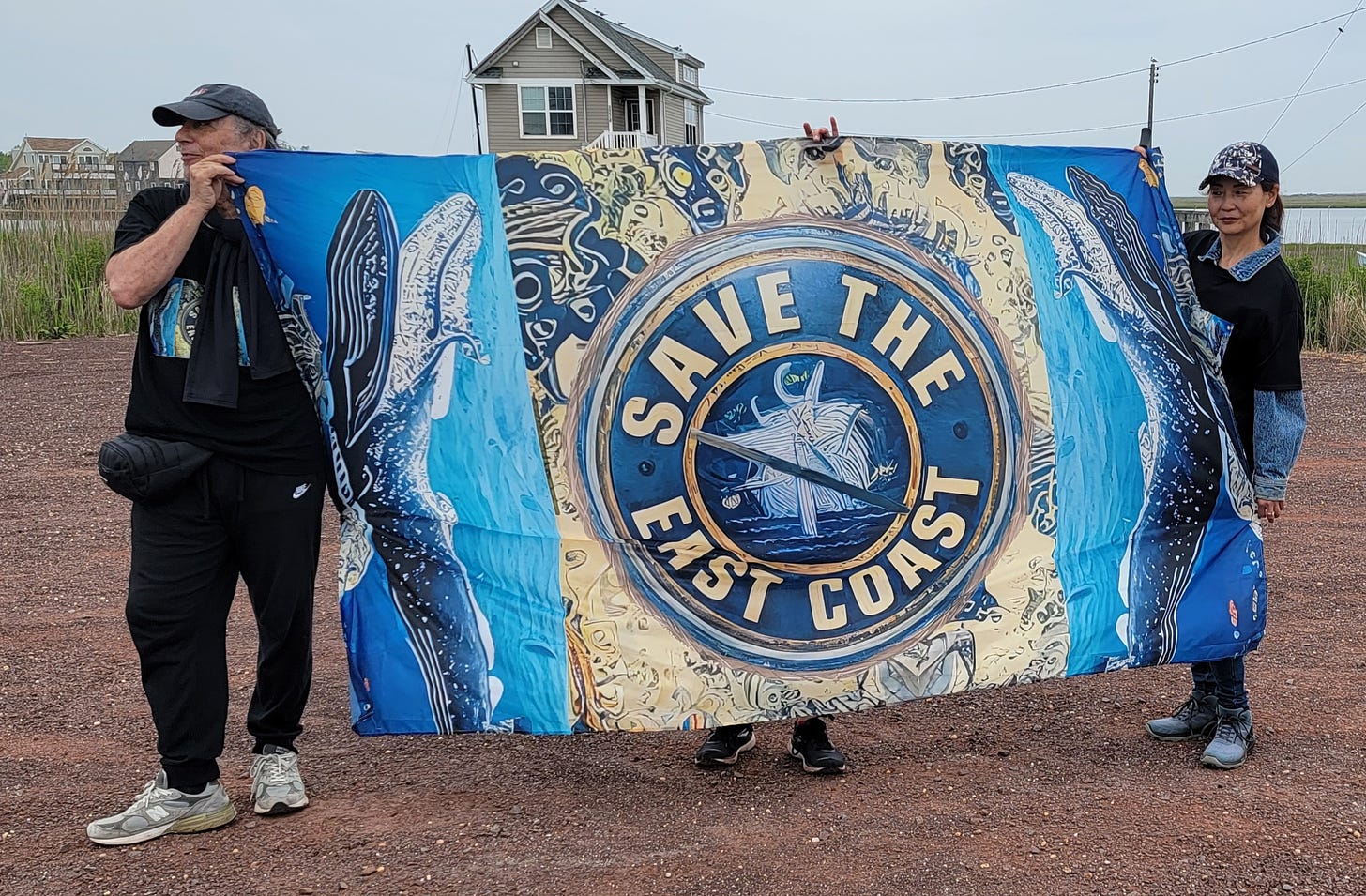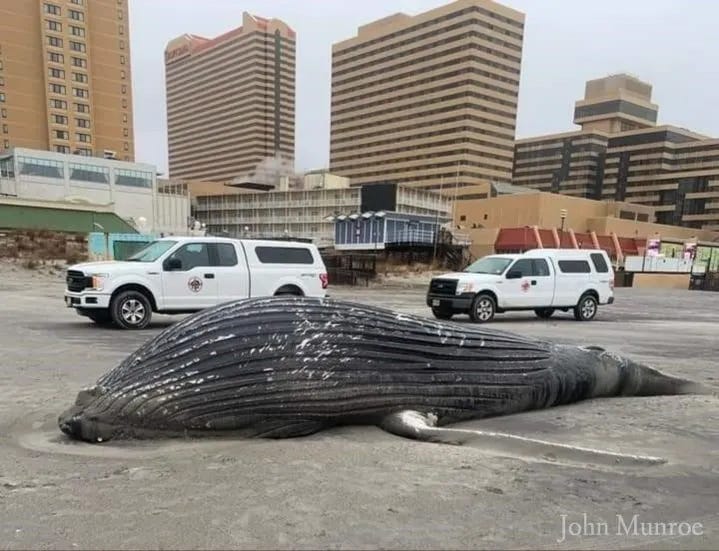Whales Die, While Officials, Media, and Environmentalists Lie
"Save the Whales" is now "sacrifice the whales" to East Coast wind turbines, oil & gas drilling, and reporter lackeys for the marine-industrial complex. Sound familiar?

In Strathmere, New Jersey, the morning of December 10, 2022, began on a somber note.
A dead whale weighing an estimated twenty tons was spotted offshore, soon moved by tide and waves to the shoreline where beachgoers took photos and videos.
Identified as a young female humpback, the thirty-foot-long cetacean was examined by experts dispatched from the Brigantine Marine Mammal Stranding Center and found to have no signs of illness or injury. Later that afternoon the local public works department brought in its heavy equipment to bury her on the beach.
Despite the fact that whale deaths happen, this particular humpback who beached herself that overcast day in Strathmere could be called Whale One. Not just a doomed marine mammal, but a creature who was the first to become emblematic of an ominous plan to industrialize the ocean as quickly as possible. A plan that has made bizarre if unacknowledged bedfellows of environmentalists and their sworn enemies who drill for fossil fuels—and a plan that makes use of the most potent greenhouse gas ever known.
The young humpback became part of a movement that began with the asking of a question: What is killing the whales and dolphins?
The not-so-silent sounds of sonar
Along the Jersey Shore, several companies, including Atlantic Shores (owned jointly by oil and gas titan Shell and the French-based utility company EDF) and Danish-based Orsted, are mapping the ocean floor—the first step toward construction of hundreds of mammoth offshore wind turbines. Many will be smack in the face of some of the wealthiest shorefront communities on the East Coast. But it wasn’t just the soon-to-be disfigurement of the magnificent ocean views that got people really agitated. It was all those dead whales and dolphins.

From last December to mid-April, there were forty-one marine mammal strandings along the New Jersey shore alone. That included nine dead humpback whales, a “dependent” female calf sperm whale that washed up alive and died on the beach, a female dolphin who died at the scene and her calf who was euthanized, and eight dolphins that were still alive when they became simultaneously stranded in Sea Isle City. Two died where they landed, and six were subsequently euthanized on the beach.
If you include New York whale strandings during that same time period, two minke whales, four more humpbacks, two sperm whales, and one unidentified whale can be added to the tally. And during the writing of this article, ten more dolphins stranded off the New Jersey coast, with another dead female minke whale, two deceased humpbacks observed floating in New York waters, and another unidentified whale washing ashore in Hempstead on East Atlantic Beach, Long Island.
People soon started questioning whether these deaths were connected to ongoing surveying activities, which use a variety of acoustic devices offshore. Boats operating different types of sonar had been increasing at a steady rate since Orsted received its first official authorization to “harass” marine mammals back in 2017. Atlantic Shores admits they have had such “vessels in the field continuously” beginning in 2019.
The federal powers-that-be, however, issued an immediate response.
There is “no evidence linking the strandings to offshore wind energy development,” said the Marine Mammal Commission, a government agency that was established by the Marine Mammal Protection Act (MMPA) of 1972 to provide “independent oversight.” The National Oceanic and Atmospheric Administration, more commonly referred to as NOAA Fisheries, agreed, as did the Bureau of Ocean Energy Management (BOEM). Quick to join in were environmental groups such as Greenpeace, which called any suggestion of a connection between whale deaths and sonar activity “a cynical disinformation campaign.”
Headlines soon started appearing, such as one in the Philadelphia Inquirer labeling suspicions of sonar involvement in whale deaths “right-wing conspiracy theories.”
The “fact check” staff at USA Today jumped in, too, saying experts find “no evidence” that “offshore wind projects are killing whales.”
But how do these experts know with such certainty that the escalating underwater din generated by multi-beam echosounders, sparkers, boomers, and CHIRPs haven’t played a role in injuring, confusing, or distressing marine mammals, potentially leading to their deaths?
They don’t. And they’ve said so numerous times.

The ‘unintentional’ take-aways
Comments to the press aside, the Marine Mammal Commission revealed in a paper that “. . . considerable uncertainty exists regarding the potential short- and long-term impacts of offshore wind development on marine mammals that occur in U.S. waters.”
The commission went on to say in that paper that all phases of wind energy development can be disrupting and disastrous to marine mammals, from the devices used in surveys that can “generate sound that may affect a marine mammal’s behavior” and lead to “serious consequences,” such as “stranding,” to the pile driving during construction to the operational sounds of completed wind turbines in use.
BOEM, a federal agency that functions within the Department of Interior, has clearly stated that offshore turbine projects involve a dazzling array of “incomplete or unavailable information.”
The BOEM-authored 1,408-page draft Environmental Impact Statement for Ocean Wind 1 regarding a lease area purchased by Orsted fifteen miles southeast of Atlantic City admits that there is “uncertainty” regarding “how Project activities and cumulative effects may affect” marine mammals. It goes on to discuss the unknown consequences of EMFs given off by extensive underwater cables that will be transmitting the power, acknowledging that “marine mammals are sensitive to, and can detect, small changes in magnetic fields.” Additional “uncertainty remains,” says BOEM, regarding “cumulative acoustic impacts” from surveys (which include sonar) to drilling and dredging.
All aspects of offshore wind energy, from development to operation, can be summarized with this statement from BOEM: “It is not possible to predict with certainty the potential long-term behavioral effects on marine mammals from project-related pile driving or other activities . . .”
As for research conducted at European offshore turbine areas, that doesn’t count for much where whales are concerned, according to BOEM, as large whales are “uncommon” in those waters.
But even with all that’s not known, something these federal agencies do know is that turbine construction and pre-construction activities are expected to “harass” marine mammals.
One of the more curious parts to the MMPA is a provision that allows for “takes,” defined as activities that “harass, hunt, capture, or kill, or attempt to harass, hunt, capture, or kill any marine mammal.”
Upon request, NOAA Fisheries will issue what are called “incidental harassment authorizations,” or IHAs, that come in two levels, A and B, for takes that are “unintentional, but not unexpected.”
Level A harassment is defined as “any act of pursuit, torment, or annoyance that has the potential to injure a marine mammal” in the wild. Level B is described as acts that can potentially “disturb a marine mammal by causing disruption of behavioral patterns, including, but not limited to, migration, breathing, nursing, breeding, feeding, or sheltering.”
For just the New Jersey-New York lease areas alone, NOAA has given out eleven active IHAs (with five pending) for pre-construction activities that represent an allowed take of tens of thousands of marine mammals—whales included.
Having those existing harassment authorizations rescinded and compelling NOAA to prepare an environmental impact statement to calculate the “cumulative effects” of such “takes” is the intent of one of the lawsuits brought against NOAA Fisheries and the U.S. Department of Commerce by the New Jersey group Save Long Beach Island and its president Robert Stern, Ph.D.
Stern, who formerly managed environmental reviews done by the U.S. Department of Energy, believes that “our best place to end this ill-conceived project is in court.” The group intends to file five more actions regarding wind-turbine development related solely to Long Beach Island, contending that numerous federal and state acts (including the MMPA) have been violated.
“Direct hearing damage is not the issue,” said Stern, “but rather disturbance of the whale’s behavior leading indirectly to serious harm and fatality. The post-mortem examinations cannot detect whether noise was a precipitating factor in a fatal outcome.”
And indeed, a just-released necropsy report from NOAA concerning a nursing dolphin and her calf that stranded at Sandy Hook, New Jersey, in February, conducted by the Cornell College of Veterinary Medicine, looked at all organs and appearances of the mother and calf and was unable to determine the cause of death in either, stating both had “no obvious injuries or signs of illness.”
Then there’s the North Atlantic right whale. With its total population numbers currently estimated at below 340, it would seem logical that any potential disruption of the remaining few hundred swimming between existence and extinction would be a deal breaker.
But apparently not. NOAA Fisheries has issued “takes” for right whales as well—lots of them.
The Save Right Whales Coalition, an alliance of environmental groups and concerned citizens, tallied up North Atlantic right whale takes for twenty-six wind-energy projects, finding an astonishing 915 level B IHAs either authorized or soon to be by NOAA. That translates into official permission to harass these critically endangered marine mammals—and at a number substantially higher than the entire remaining population.
By February, thirty mayors of Garden State shore-area communities, including Long Beach Township, Ocean City, and Point Pleasant, wrote to President Biden and Democratic Governor Phil Murphy calling for an immediate moratorium on offshore wind activities.
And distress over the increasing numbers of strandings seemed to come to a head in mid-March when an overflow crowd filled the Wildwood Convention Center for a hearing called by U.S. Rep. Jeff Van Drew (R), who described the offshore turbine development as the “most profound transformation of the Atlantic Coast in the history of the United States.”
Stern testified at the hearing along with Cindy Zipf, executive director of Clean Ocean Action (COA) out of Long Branch, New Jersey, one of the few environmental groups that dares to suggest a possible link between the strandings and offshore wind activities.
“Marine life is being placed at grave risk,” Zipf testified, “without scientific due diligence, monitoring, and protection.”
A petition started by COA asking for a “hard stop” to all offshore wind activities until an independent investigation takes place has over 380,000 signatures.
In mid-June the Government Accountability Office (GAO) agreed to launch an investigation into wind energy off the New Jersey coast, specifically looking into how it will affect marine mammals and the ocean ecology, the commercial fishing industry, military operations and air and navigational safety. The study was requested by Rep. Chris Smith (R-NJ), Jeff Van Drew (R-NJ), Andy Harris (R-MD), and Chairman Bruce Westerman (R-AR) of the House Committee on Natural Resources.
But any investigation looking for hearing damage from sonar and other noise on marine mammals will be a long shot at best.
Currently, the Office of Naval Research is conducting an ongoing study funded by BOEM, which is attempting to learn about the hearing of baleen whales such as the humpback, minke, and North Atlantic right whale, the current understanding of which, according to the investigators, “is almost nonexistent.” Any findings are not expected for several years.
Hearing damage, however, isn’t the only possible peril to marine mammals.
In 2018, researchers from Woods Hole Oceanographic Institution published a study investigating how deep-diving marine mammals avoid getting decompression sickness, a.k.a. the bends, via a unique lung structure that prevents this extremely painful and life-threatening condition. The scientists noted that “excessive stress, as may occur during exposure to human-made sound, may cause the system to fail . . . and nitrogen would increase in the blood and tissues” during their ascent to the surface. That is believed to be the cause of death for fourteen whales that stranded in the Canary Islands following Naval sonar activities there in 2002.
“There have been many whale strandings around the world associated with surveys using air guns and mid-frequency sonars which are not that different from the sparker units used here,” said Stern. “There are no reports in the U.S. because such correlations are not investigated.”
And not unlike the past three years of controversy surrounding covid, offshore wind development has become a truly partisan issue.
An online hearing was held at the beginning of May by four New Jersey Republican state senators, again asking for a moratorium on offshore wind-related activities, while, at the same time, Democrats held their own event hyping the economic benefits of offshore wind.
A ‘climate suicide pact’
Although the first wave of 1,500 offshore wind turbines planned from southeastern New England to the Carolina coast, including areas off the Delmarva Peninsula and the environmentally fragile Outer Banks, will put untold numbers of marine animals and shore birds in peril, it appears that most environmentalists are willing to sacrifice just about anything when it comes to the phasing out of fossil fuels.
But in actuality, more wind turbines mean more opportunities for oil and gas drilling.
Buried deep in President Biden’s 755-page Inflation Reduction Act of 2022 (IRA) are provisions that promote drilling for oil and gas both onshore and offshore. Not only are post-IRA onshore wind leases now tethered to the offering of federally owned land for the extraction of fossil fuels, but offshore wind leases also became predicated on making available a whopping sixty million acres of seabed for the purpose of oil and gas drilling the year before any new offshore turbine leases can be tendered. And that’s for the next ten years.
“This is a climate suicide pact” said Brett Hartl, affairs director at the Center for Biological Diversity of the IRA plan, calling it “self-defeating to handcuff renewable energy development to massive new oil and gas extraction.”
And it’s not just the turbines. Solar energy “farms” on leased federal land are also bound by similar nods to the oil and gas industry involving the offering-up of millions of acres for fossil fuel extraction.
Greenpeace Research Manager Tim Donaghy described the IRA provisions to this reporter in an email as “. . . giveaways to the fossil fuel industry.” Several other groups that are big backers of offshore wind, such as the Audubon Society and the NRDC, declined to comment.

Like ‘bleached whale bones’
The fact that wind turbines only have a useful life of around twenty years is not often discussed by the industry. But the decommissioning of an offshore wind “farm,” something covered in numerous official documents, may be just as disastrous to marine life as their installation.
The removal process is described as a “reverse installation” requiring a large “jack-up” vessel able to handle the collective load of the blades, towers, and other components that will be hauled away. “Offshore wind turbines have a large amount of material that must be removed after the structures are decommissioned,” writes Orsted in its Construction and Operations Plan for the Ocean Wind site.
But where will it all go?
Since they currently can’t be recycled, thousands of mothballed turbine blades from decommissioned onshore installations are presently being dumped in landfills. And not just any landfills, but special ones large enough to accommodate their extreme size, which has been compared to the wingspan of a Boeing 747 or even a football field. These humongous fiberglass-containing pieces of wind junk require a special type of blade to cut them into transportable lengths. Stacked piles of defunct turbine blades were likened by one observer to “bleached whale bones” as they awaited burial at a landfill in Casper, Wyoming.
But perhaps the most incongruously dirty aspect of this supposedly clean, “green” energy is the utilization of the most potent and persistent greenhouse gas known to man, sulfur hexafluoride (SF6), which is used both in the turbines and the onshore and offshore substations.
A manmade fluorinated compound widely used in the electrical industry, SF6 has the distinction of being extremely stable, so that once released, it accumulates in the atmosphere for centuries, with an “atmospheric lifetime of 3,200 years,” according to the EPA, which says a “relatively small amount can “have a significant impact on global climate change.”
Leaks of this disastrous greenhouse gas from equipment can occur during “installation, maintenance and servicing, and decommissioning,” according to the EPA.
In June of 2022, eighty workers at the Seagreen offshore wind area in the North Sea were forced to evacuate their rig when around twenty-four pounds of SF6 leaked, as revealed by a representative of an EU union group to the media. The question remains, he noted, of how many such leaks go unreported.
Orsted lists in its construction plans for the Ocean Wind site up to 243 pounds of SF6 per wind turbine generator (with up to ninety-eight scheduled to be erected) and 793 gallons of SF6 utilized in each of up to three offshore substations. (An Orsted spokesperson would only confirm the company’s use of the gas but declined to answer any additional questions regarding it.)
Atlantic Shores mentions SF6 use only once in its construction plans for one of its lease areas, later referring to it as “switchgear, electrical insulator/arc suppressor.” Each of its wind turbine generators would use 243 pounds of the gas, with offshore substations requiring varying amounts from over 3,000 to 9,480 pounds. If also used in the onshore substations, another 11,000 pounds of this potent greenhouse gas will be needed. At present, the company plans on constructing up to 200 wind turbines and five offshore substations in two lease areas running from Atlantic City north to Barnegat Light at the tip of Long Beach Island, a distance of about thirty-two miles.

The blight on the bight
Extending from Cape May, New Jersey, to Montauk Point, Long Island, is the New York Bight. (A bight, as defined by NOAA is “a long, gradual bend or recess in the shoreline that forms a large, open bay.”) That particular area of open ocean was earmarked back in 2021 by the Biden administration as a launching site for its “clean energy economy” plan. The resulting lease auctions by BOEM in February of 2022 took in a record-setting $4.3 billion and set the stage for turbines to appear across another 480,000 acres of East Coast seascape.
Although conservationists such as the director for the Association of New Jersey Environmental Commissions states that offshore wind “positions New Jersey as a leader in fighting climate change,” not everyone agrees it will really matter all that much.
None other than BOEM, in the final environmental impact statement for Vineyard Wind 1, an offshore wind lease area off Martha’s Vineyard, Massachusetts, acknowledges that “U.S. offshore wind projects would by themselves probably have a limited impact on global emissions and climate change . . .” but are “integral for fulfilling state plans.”
“It’s a disingenuous process right now,” says Stern with Save Long Beach Island. “Nobody is looking at the bigger picture. Perhaps they just don’t care to look.”
At the end of April, the Belgium-flagged heavy-lift vessel Orion left Rotterdam heading to the site of Vineyard Wind to start the pounding of 2,000 ton steel monopiles into the seabed to support towers that will rise over 800 feet above the ocean.
By the beginning of June, Vineyard Wind sent out a celebratory press release quoting its CEO, Klaus Moeller, as stating “We can finally say it—as of today, there is ‘steel in the water.’”
But only a week later, the tide delivered two dead humpbacks to the beaches in Edgartown, a tourist spot on Martha’s Vineyard that was, ironically, a major whaling port over two centuries ago.





This is horrifying. Oil and gas are not nearly as dangerous or long-lasting as SF6.
The gang of heartless, greedy bastards running the United States and lying through corrupted media are actually taking all creatures headlong to complete destruction. 💔
Horrible! "beaching themselves" is a euphemism fro COMMITTING SUICIDE. These are not animals that don;' know oceans tides and currents; they are extremely intelligent but the pain and discomfort is too much, so they, like humans under extreme stress often choose to die to escape. THIS MUST STOP.